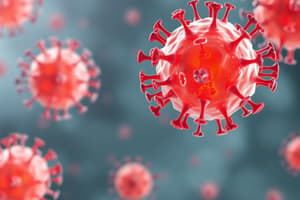Podcast
Questions and Answers
What does IL-2 stimulate the proliferation of?
What does IL-2 stimulate the proliferation of?
antigen-primed (helper) T cells
Which cytokine is a growth factor that stimulates the proliferation of antigen-primed (helper) T cells?
Which cytokine is a growth factor that stimulates the proliferation of antigen-primed (helper) T cells?
- TNF-a
- IL-15
- IL-2 (correct)
- IFN-γ
Cyclosporine decreases the immune response by increasing the production of IL-2.
Cyclosporine decreases the immune response by increasing the production of IL-2.
False (B)
Cyclosporine preferentially suppresses _____ mediated immune reactions.
Cyclosporine preferentially suppresses _____ mediated immune reactions.
Match the immunosuppressive drug with its mechanism of action:
Match the immunosuppressive drug with its mechanism of action:
What is Everolimus a substrate of?
What is Everolimus a substrate of?
Which drug can replace azathioprine due to its safety and efficacy?
Which drug can replace azathioprine due to its safety and efficacy?
Type IV hypersensitivity reactions are antibody-mediated.
Type IV hypersensitivity reactions are antibody-mediated.
Drugs that commonly cause type I reactions include penicillins and ____________.
Drugs that commonly cause type I reactions include penicillins and ____________.
Match the autoimmune syndromes with their corresponding drugs:
Match the autoimmune syndromes with their corresponding drugs:
Flashcards are hidden until you start studying
Study Notes
Introduction to Immunopharmacology
- The immune system plays a crucial role in protecting the body against harmful foreign molecules.
- However, in some cases, this protection can result in serious problems, such as rejection of transplanted organs or tissues.
- Immunosuppressive drugs are used to prevent or treat graft rejection.
The Immune Activation Cascade
- The immune activation cascade is a three-signal model:
- Signal 1: T-cell triggering at the CD3 receptor complex by an antigen on the surface of an antigen-presenting cell (APC).
- Signal 2: Engagement of CD80 and CD86 on APCs with CD28 on T cells.
- Signal 3: IL-2 binds to CD25 on the surface of other T cells to activate mTOR, stimulating T-cell proliferation.
Classification of Immunosuppressive Drugs
- Immunosuppressive drugs can be categorized according to their mechanisms of action:
- Interference with cytokine production or action
- Disruption of cell metabolism, preventing lymphocyte proliferation
- Blockade of T-cell surface molecules
Selective Inhibitors of Cytokine Production and Function
- Examples include cyclosporine, everolimus, sirolimus, and tacrolimus.
- These drugs target specific cytokines, such as IL-2, to dampen the immune response.
Cyclosporine
- Mechanism of action: binds to cyclophilin, forming a complex that inhibits calcineurin, preventing the production of cytokines such as IL-2.
- Used to prevent rejection of kidney, liver, and cardiac allogeneic transplants.
- Adverse effects: nephrotoxicity, hypertension, hyperlipidemia, hyperkalemia, tremor, hirsutism, glucose intolerance, and gum hyperplasia.
Tacrolimus (FK506)
- Mechanism of action: similar to cyclosporine, but binds to a different immunophilin, FKBP-12.
- Used to prevent rejection of liver and kidney transplants.
- Adverse effects: nephrotoxicity, neurotoxicity, hyperlipidemia, hypertension, and diabetes mellitus.
Sirolimus
- Mechanism of action: binds to mTOR, interfering with Signal 3, and blocking the progression of activated T cells from the G1 to the S phase of the cell cycle.
- Used in renal transplantation, and in combination with cyclosporine and corticosteroids.
- Adverse effects: hyperlipidemia, impaired or delayed wound healing, and enhanced nephrotoxicity in combination with higher doses of cyclosporine.
Everolimus
- Mechanism of action: same as sirolimus, inhibiting mTOR and blocking T-cell proliferation.
- Used in renal transplantation, and in combination with low-dose cyclosporine and corticosteroids.
- Adverse effects: similar to sirolimus, including hyperlipidemia, impaired or delayed wound healing, and enhanced nephrotoxicity.
Immunosuppressive Antimetabolites
- Examples include azathioprine, mycophenolate mofetil, and mycophenolate sodium.
- These drugs are used in combination with corticosteroids and calcineurin inhibitors to prevent rejection of transplanted organs.
Azathioprine
- Mechanism of action: converted to 6-mercaptopurine, which inhibits the synthesis of inosine monophosphate, a key component of nucleic acid synthesis.
- Used to prevent rejection of transplanted organs.
- Adverse effects: bone marrow suppression, nausea, and vomiting.
Mycophenolate Mofetil
- Mechanism of action: inhibits the synthesis of guanosine monophosphate, blocking the proliferation of T and B cells.
- Used in combination with corticosteroids and calcineurin inhibitors to prevent rejection of transplanted organs.
- Adverse effects: diarrhea, nausea, vomiting, abdominal pain, leukopenia, and anemia.
Antibodies
- Examples include antithymocyte globulins, muromonab-CD3, daclizumab, and basiliximab.
- These drugs are used to prevent or treat rejection of transplanted organs.
Antithymocyte Globulins
- Mechanism of action: binds to the surface of circulating T lymphocytes, leading to their destruction and lymphopenia.
- Used to prevent or treat rejection of transplanted organs.
- Adverse effects: chills, fever, leukopenia, thrombocytopenia, infections, and skin rashes.
Corticosteroids
- Mechanism of action: inhibits the synthesis of prostaglandins, leukotrienes, cytokines, and other signaling molecules that participate in immune responses.
- Used to suppress immunologic reactions in patients who undergo organ transplantation.
- Adverse effects: adrenal suppression, growth inhibition, osteoporosis, salt retention, glucose intolerance, and behavioral changes.
Immunomodulating Agents
- Examples include aldesleukin, which is recombinant interleukin-2 (IL-2).
- These drugs are used to stimulate immune responses, and have the potential to treat immune deficiency diseases, chronic infectious diseases, and cancer.
Mechanisms of Drug Allergy
-
Immunologic reactions to drugs can fall into any of the 4 categories of hypersensitivity reactions: Type I (Immediate), Type II, Type III, and Type IV.### Type I (Immediate) Sensitivity Allergy
-
Occurs when a drug covalently links to a host carrier protein (hapten)
-
The immune system detects the drug-hapten conjugate and initiates B-cell proliferation and formation of IgE antibodies
-
Fixation of IgE antibodies to high-affinity Fc receptors (FcRs) on blood basophils or mast cells sets the stage for an acute allergic reaction
-
Examples of drugs that commonly cause type I reactions include penicillins and sulfonamides
Autoimmune (Type II) Reactions to Drugs
- Certain autoimmune syndromes can be induced by drugs
- Examples of autoimmune syndromes include hemolytic anemia from methyldopa, systemic lupus erythematosus from hydralazine, thrombocytopenic purpura from quinidine, and agranulocytosis from exposure to many drugs such as clozapine
- In these drug-induced autoimmune states, IgG antibodies bind to drug-modified tissue and are destroyed by the complement system or by phagocytic cells with Fc receptors
- Autoimmune reactions to drugs usually subside within several months after the offending drug is withdrawn
Type III Drug Allergy
- Immunologic reactions to drugs resulting in serum sickness
- Clinical features include urticarial and erythematous skin eruptions, arthralgia or arthritis, lymphadenopathy, glomerulonephritis, peripheral edema, and fever
- Reactions generally last 6–12 days and usually subside once the offending drug is eliminated
- Antibodies of the IgM or IgG class are usually involved
- Mechanism of tissue injury involves immune complex formation and deposition on basement membranes, followed by complement activation and infiltration of leukocytes, causing tissue destruction
- Examples of type III reactions include drug-induced serum sickness and vasculitis, and Stevens-Johnson syndrome
Type IV Drug Allergy
- Type IV hypersensitivity is often called delayed type hypersensitivity
- Reaction takes two to three days to develop
- Unlike the other types, it is not antibody-mediated but rather is a type of cell-mediated response
- Occurs from topical application of drugs
- Results in contact dermatitis
Studying That Suits You
Use AI to generate personalized quizzes and flashcards to suit your learning preferences.





